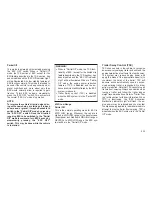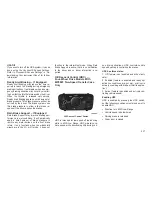
Electronic Stability Control (ESC)
This system enhances directional control and
stability of the vehicle under various driving
conditions. ESC corrects for oversteering or
understeering of the vehicle by applying the
brake of the appropriate wheel to assist in
counteracting the oversteer or understeer con-
dition. Engine power may also be reduced to
help the vehicle maintain the desired path.
ESC uses sensors in the vehicle to determine
the vehicle path intended by the driver and
compares it to the actual path of the vehicle.
When the actual path does not match the
intended path, ESC applies the brake of the
appropriate wheel to assist in counteracting the
oversteer or understeer condition.
•
Oversteer - when the vehicle is turning more
than appropriate for the steering wheel position.
•
Understeer - when the vehicle is turning less
than appropriate for the steering wheel
position.
The
“ESC
Activation/Malfunction
Indicator
Light” located in the instrument cluster will start
to flash as soon as the tires lose traction and the
ESC system becomes active. The “ESC
Activation/Malfunction
Indicator
Light”
also
flashes when the TCS is active. If the “ESC
Activation/Malfunction Indicator Light” begins to
flash during acceleration, ease up on the accel-
erator and apply as little throttle as possible. Be
sure to adapt your speed and driving to the
prevailing road conditions.
WARNING!
The Electronic Stability Control (ESC) can-
not prevent the natural laws of physics from
acting on the vehicle, nor can it increase the
traction afforded by prevailing road condi-
tions. ESC cannot prevent collisions, includ-
ing those resulting from excessive speed in
turns, driving on very slippery surfaces, or
hydroplaning. ESC also cannot prevent col-
lisions resulting from loss of vehicle control
due to inappropriate driver input for the con-
ditions. Only a safe, attentive, and skillful
driver can prevent collisions. The capabilities
of an ESC equipped vehicle must never be
exploited in a reckless or dangerous manner
(Continued)
WARNING! (Continued)
which could jeopardize the user’s safety or
the safety of others.
The ESC system has two available operating
modes in 4WD HIGH range and two-wheel
drive vehicles, and one operating mode in 4WD
LOW range.
High Range (Four-Wheel Drive Models) Or
Two-Wheel Drive Models
On
This is the normal operating mode for ESC in
4WD HIGH range and in two-wheel drive ve-
hicles. Whenever the vehicle is started or the
transfer case (if equipped) is shifted from 4WD
LOW range or NEUTRAL back to 4WD HIGH
range, the ESC system will be in this “On”
mode. This mode should be used for most
driving situations. ESC should only be turned to
“Partial Off” mode for specific reasons as noted
below.
234
Summary of Contents for Grand Cherokee SRT 2014
Page 1: ......
Page 3: ......
Page 4: ......
Page 6: ...2...
Page 11: ...7...
Page 68: ...64...
Page 154: ...INSTRUMENT CLUSTER 150...
Page 203: ...Control Setting Suggestions for Various Weather Conditions 199...
Page 204: ...200...
Page 276: ...272...
Page 330: ...326...
Page 331: ...8 MAINTENANCE SCHEDULES MAINTENANCE SCHEDULE 328 327...
Page 332: ...MAINTENANCE SCHEDULE Refer to the Service and Warranty Handbook for maintenance schedules 328...
Page 333: ...9 IF YOU NEED CONSUMER ASSISTANCE IF YOU NEED ASSISTANCE 330 329...
Page 335: ...331...
Page 336: ...332...
Page 337: ...10 INDEX 333...
















































